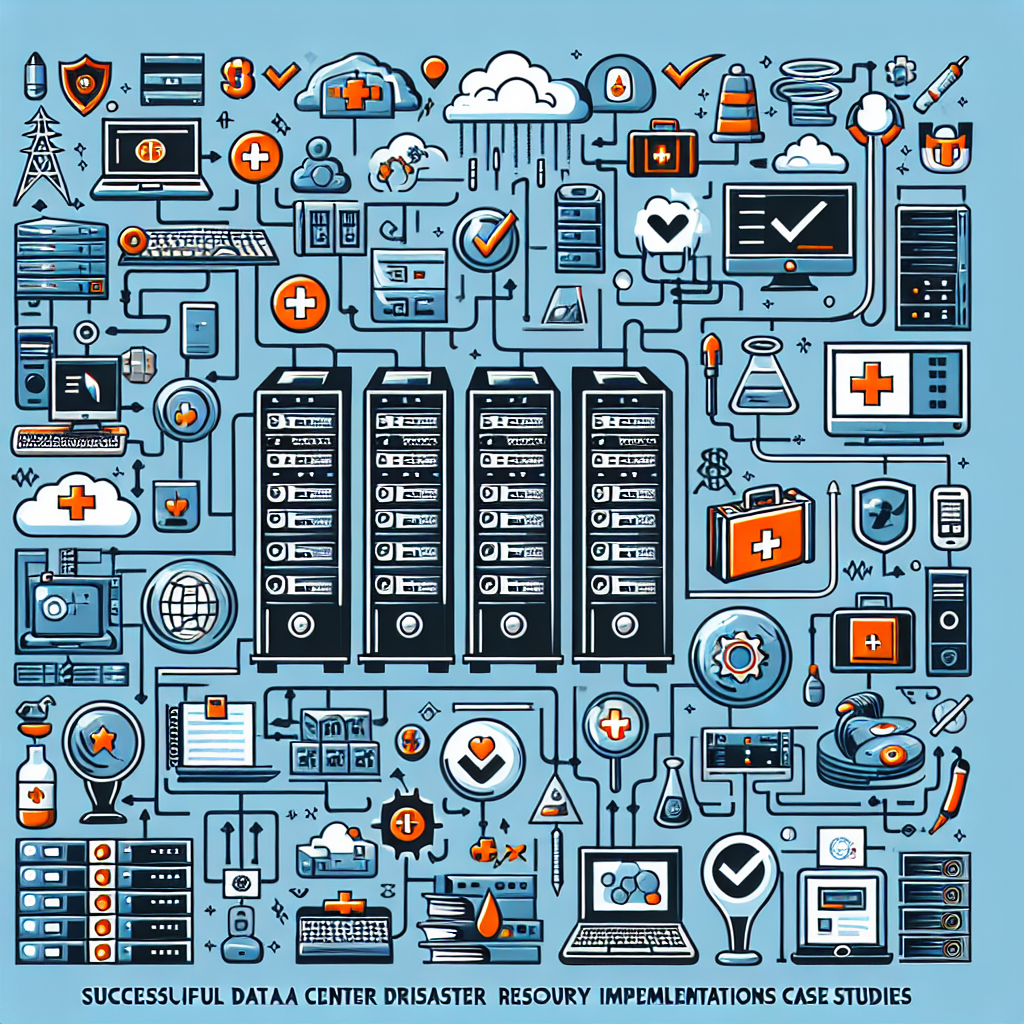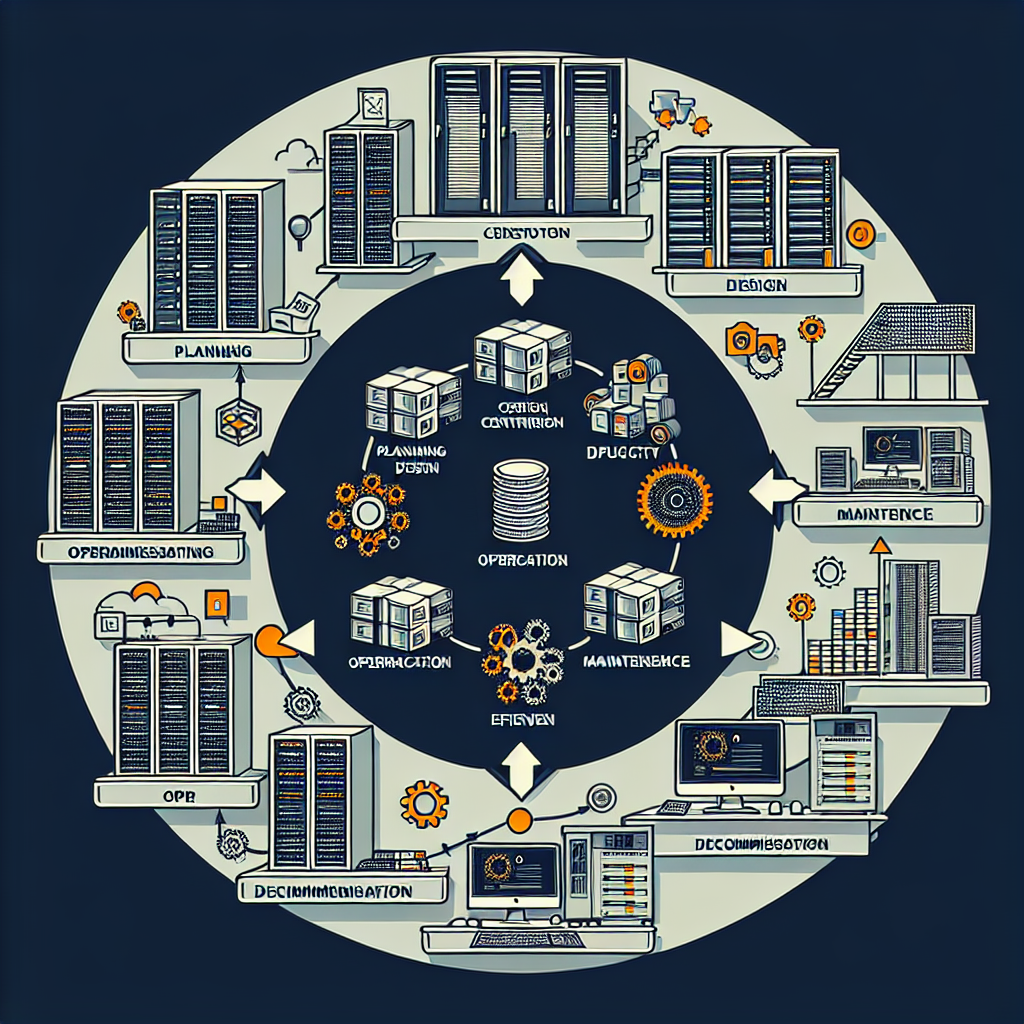Your cart is currently empty!
Tag: Successful

Key Components of a Successful Data Center Audit
In today’s digital age, data centers play a crucial role in ensuring the smooth operations of businesses and organizations. These facilities house and manage the critical infrastructure that stores and processes vast amounts of data, making them integral to the functioning of various industries. Given the importance of data centers, it is essential to conduct regular audits to ensure that they are operating efficiently and effectively.A data center audit is a comprehensive assessment of the facility’s infrastructure, systems, and processes to identify any potential issues or areas for improvement. By conducting regular audits, organizations can ensure that their data centers are compliant with industry standards, secure, and optimized for performance. To ensure the success of a data center audit, there are key components that must be considered:
1. Physical Infrastructure: The physical infrastructure of a data center includes the building, cooling systems, power supply, and cabling. During an audit, it is essential to evaluate the condition of the infrastructure to ensure that it is secure, reliable, and resilient. This includes checking for any signs of wear and tear, potential points of failure, and compliance with industry standards.
2. Security: Data centers house sensitive and critical information, making security a top priority. A successful audit should assess the facility’s security measures, including access control, surveillance systems, and cybersecurity protocols. It is crucial to ensure that the data center is protected from physical and cyber threats to prevent unauthorized access or data breaches.
3. Compliance: Data centers are subject to various regulations and industry standards, such as the Payment Card Industry Data Security Standard (PCI DSS) and the Health Insurance Portability and Accountability Act (HIPAA). During an audit, it is important to verify that the data center is compliant with these regulations and standards to avoid potential legal and financial consequences.
4. Performance and Efficiency: To ensure optimal performance and efficiency, it is essential to assess the data center’s capacity, cooling systems, power usage, and overall energy efficiency. By evaluating these factors, organizations can identify any bottlenecks or inefficiencies that may impact the data center’s performance and make necessary improvements.
5. Disaster Recovery and Business Continuity: Data centers play a critical role in ensuring business continuity in the event of a disaster or outage. A successful audit should assess the data center’s disaster recovery plans, backup systems, and redundancy measures to ensure that critical data and operations can be restored quickly and effectively.
In conclusion, a successful data center audit is essential for ensuring the reliability, security, and efficiency of a data center. By considering key components such as physical infrastructure, security, compliance, performance, and disaster recovery, organizations can identify and address any issues or vulnerabilities that may impact the data center’s operations. Conducting regular audits will help organizations maintain a robust and resilient data center that can support their business needs effectively.

The Key Components of a Successful Data Center Business Continuity Plan
In today’s digital age, data centers play a crucial role in storing and managing vast amounts of information for businesses of all sizes. However, with the increasing reliance on data centers, it is imperative for businesses to have a solid business continuity plan in place to ensure uninterrupted operations in the event of a disaster.A data center business continuity plan is a comprehensive strategy that outlines the procedures and protocols for maintaining essential functions during and after a disruption. This plan is essential for ensuring the availability, integrity, and security of critical data and applications.
There are several key components that are essential for a successful data center business continuity plan:
1. Risk Assessment: The first step in developing a business continuity plan is to conduct a thorough risk assessment to identify potential threats and vulnerabilities that could impact the data center. This includes natural disasters, cyber-attacks, power outages, and equipment failures.
2. Business Impact Analysis: A business impact analysis helps determine the potential impact of a disruption on the organization’s operations, revenue, and reputation. This analysis helps prioritize critical functions and resources that need to be protected during a disaster.
3. Recovery Objectives: Establishing recovery objectives is crucial for determining the time frame within which critical systems and applications need to be restored after a disruption. Recovery objectives should be based on the organization’s tolerance for downtime and data loss.
4. Backup and Recovery: Implementing a robust backup and recovery strategy is essential for ensuring the availability and integrity of data in the event of a disaster. This includes regular backups, offsite storage, and testing of recovery procedures.
5. Communication Plan: A communication plan outlines the procedures for notifying stakeholders, employees, and customers in the event of a disruption. Effective communication is key to managing the response to a disaster and minimizing the impact on the organization.
6. Training and Testing: Regular training and testing of the business continuity plan are essential for ensuring that employees are familiar with their roles and responsibilities during a disaster. Testing helps identify gaps in the plan and allows for adjustments to be made as needed.
7. Continuous Improvement: Business continuity planning is an ongoing process that requires regular review and updates to ensure its effectiveness. Continuous improvement involves monitoring and evaluating the plan, making adjustments based on lessons learned from past incidents, and incorporating new technologies and best practices.
In conclusion, a successful data center business continuity plan is essential for ensuring the availability and integrity of critical data and applications in the event of a disaster. By incorporating key components such as risk assessment, business impact analysis, backup and recovery, communication plan, training, and testing, businesses can minimize downtime and mitigate the impact of disruptions on their operations. Investing in a comprehensive business continuity plan is crucial for safeguarding the future of the organization and maintaining the trust of customers and stakeholders.

Case Studies: Successful Data Center Disaster Recovery Implementations
In today’s digital age, data is king. Organizations rely heavily on their data to make informed decisions, drive innovation, and ultimately stay competitive in the market. With the increasing reliance on data, the need for robust disaster recovery solutions has become more critical than ever before.Data center disasters can strike at any time, whether it be due to natural disasters, cyber attacks, or human error. Without a solid disaster recovery plan in place, organizations risk losing valuable data, facing extended downtime, and potentially damaging their reputation.
However, there are organizations that have successfully implemented data center disaster recovery solutions, allowing them to recover quickly and minimize the impact of any potential disasters. These case studies provide valuable insights into how organizations can effectively protect their data and ensure business continuity in the face of adversity.
One such case study is that of a large financial services company that experienced a major data center outage due to a power failure. The company had implemented a comprehensive disaster recovery plan that included regular backups, redundant systems, and a failover site in a different location. When the power failure occurred, the company was able to quickly switch over to its failover site, allowing them to continue operations without any major disruptions.
Another example is that of a healthcare organization that fell victim to a ransomware attack. The organization had implemented a robust disaster recovery solution that included real-time data replication and automated failover. When the ransomware attack occurred, the organization was able to quickly restore its systems from the replicated data and resume operations without paying the ransom.
These case studies highlight the importance of having a solid disaster recovery plan in place. By implementing best practices such as regular backups, redundant systems, and failover sites, organizations can ensure that they are well-prepared to handle any data center disasters that may come their way.
In conclusion, successful data center disaster recovery implementations are crucial for organizations looking to protect their data and ensure business continuity. By learning from case studies of organizations that have successfully implemented disaster recovery solutions, organizations can gain valuable insights into how to effectively protect their data and minimize the impact of any potential disasters.

Case Studies in Successful Data Center Repair and Recovery Strategies
Data centers are the backbone of today’s digital infrastructure, powering everything from e-commerce websites to cloud services. However, even the most advanced data centers can experience downtime due to hardware failures, natural disasters, or cyberattacks. In these situations, having a solid repair and recovery strategy in place is crucial to minimizing downtime and ensuring business continuity.In this article, we will explore some case studies of successful data center repair and recovery strategies that have helped companies bounce back from unexpected disruptions.
Case Study 1: Amazon Web Services (AWS)
In February 2017, AWS experienced a massive outage that affected thousands of websites and online services. The outage was caused by a human error during routine maintenance, which led to a cascading failure of their S3 storage service. Despite the scale of the outage, AWS was able to restore service within a few hours thanks to their robust recovery strategy.
AWS had implemented a multi-region architecture, which allowed them to quickly failover to backup servers in other regions. They also had automated monitoring and alerting systems in place that alerted their engineers to the issue immediately. By having redundant systems, automated failover mechanisms, and a well-trained team, AWS was able to minimize the impact of the outage on their customers.
Case Study 2: Google
In 2019, Google experienced a network outage that affected their services, including Gmail, YouTube, and Google Cloud. The outage was caused by a configuration error that led to a traffic shift onto a neighboring network, overwhelming the system. Despite the widespread disruption, Google was able to restore service within a few hours.
Google’s recovery strategy included automated failover mechanisms and redundant systems that allowed them to quickly reroute traffic and isolate the issue. They also had a team of experienced engineers who were able to diagnose the problem and implement a solution in a timely manner. By having a proactive monitoring system and a skilled team, Google was able to recover from the outage with minimal impact on their users.
Case Study 3: Equinix
Equinix, a global data center provider, faced a major outage in 2020 when a fire broke out at their data center in France. The fire caused extensive damage to the facility and disrupted services for several of their customers. Despite the severity of the situation, Equinix was able to recover quickly and restore service to their customers.
Equinix had a comprehensive disaster recovery plan in place that included backup power supplies, redundant cooling systems, and fire suppression mechanisms. They also had a team of trained professionals who were able to quickly assess the damage and implement a recovery plan. By having a well-documented disaster recovery plan and a responsive team, Equinix was able to mitigate the impact of the fire and restore service to their customers in a timely manner.
In conclusion, these case studies demonstrate the importance of having a solid data center repair and recovery strategy in place. By implementing redundant systems, automated failover mechanisms, and a well-trained team, companies can minimize downtime and ensure business continuity in the face of unexpected disruptions. Data center providers should prioritize investing in robust recovery strategies to protect their customers and maintain their reputation in the industry.

Implementing a Successful Preventative Maintenance Plan for Your Data Center
Data centers are the backbone of any organization, housing the critical IT infrastructure that keeps businesses running smoothly. With the increasing reliance on digital technology, ensuring the uninterrupted operation of data centers has become more important than ever. Implementing a successful preventative maintenance plan is key to keeping data centers functioning at peak performance and minimizing the risk of costly downtime.Preventative maintenance involves performing routine inspections, tests, and repairs on data center equipment to identify and address potential issues before they escalate into major problems. By proactively addressing maintenance needs, organizations can prolong the lifespan of their equipment, reduce the likelihood of unexpected failures, and optimize the overall efficiency of their data center operations.
To implement a successful preventative maintenance plan for your data center, consider the following steps:
1. Conduct a thorough assessment: Start by conducting a comprehensive assessment of your data center infrastructure to identify all critical equipment and systems that require regular maintenance. This includes servers, cooling systems, power distribution units, and environmental monitoring devices.
2. Develop a maintenance schedule: Create a detailed maintenance schedule that outlines the frequency and scope of maintenance tasks for each piece of equipment. Consider factors such as manufacturer recommendations, industry best practices, and the specific needs of your data center environment.
3. Establish clear procedures: Develop standardized procedures for performing maintenance tasks, including safety protocols, equipment shutdown procedures, and documentation requirements. Ensure that all data center staff are trained on these procedures and follow them consistently.
4. Implement a tracking system: Use a maintenance tracking system to record and monitor all maintenance activities, including the date and time of each task, the technician responsible, and any issues or repairs that were made. This information can help identify trends, track equipment performance, and plan future maintenance needs.
5. Regularly review and update the plan: Regularly review and update your preventative maintenance plan to ensure that it remains relevant and effective. Consider feedback from data center staff, changes in equipment or technology, and any new industry regulations or guidelines that may impact your maintenance practices.
By implementing a successful preventative maintenance plan for your data center, you can minimize the risk of downtime, optimize equipment performance, and extend the lifespan of your critical IT infrastructure. Investing time and resources in preventative maintenance now can save you time, money, and headaches down the road.

Improving Incident Response in Data Centers: Strategies for Successful Problem Resolution
Data centers are the backbone of modern businesses, housing critical infrastructure and sensitive data that keep operations running smoothly. However, incidents and outages can occur at any time, disrupting services and causing downtime that can have significant financial and reputational impacts.In order to effectively mitigate and resolve incidents in data centers, it is crucial for organizations to have a well-defined incident response plan in place. By following a set of strategies and best practices, businesses can improve their incident response capabilities and ensure successful problem resolution.
One key strategy for improving incident response in data centers is to establish clear communication channels and escalation procedures. It is important for all stakeholders, including IT staff, management, and external vendors, to be aware of their roles and responsibilities during an incident. Regularly scheduled drills and simulations can help ensure that everyone knows how to respond effectively in a crisis.
Another important aspect of incident response is to prioritize incidents based on their impact and urgency. By categorizing incidents according to severity, organizations can ensure that resources are allocated appropriately and that critical issues are addressed promptly. This can help minimize downtime and mitigate the potential impact on business operations.
In addition, having a comprehensive incident tracking and management system in place can help organizations monitor and analyze incidents in real-time. By capturing data on incident trends and root causes, businesses can identify recurring issues and implement proactive measures to prevent future incidents.
Furthermore, it is essential for organizations to regularly review and update their incident response plan to ensure that it remains relevant and effective. As technology and business requirements evolve, so too should the incident response strategy to address new threats and vulnerabilities.
Overall, improving incident response in data centers requires a combination of effective communication, proper prioritization, robust incident tracking, and continuous improvement. By implementing these strategies, organizations can enhance their problem resolution capabilities and minimize the impact of incidents on their operations.

Best Practices for Successful Data Center Lifecycle Management
Data centers are the backbone of modern businesses, providing the necessary infrastructure for storing, processing, and managing vast amounts of data. With data centers playing such a crucial role in today’s digital economy, it’s essential for organizations to implement best practices for successful data center lifecycle management.Data center lifecycle management involves the planning, design, construction, operation, and maintenance of the data center infrastructure. By following best practices, organizations can ensure that their data centers are efficient, secure, and reliable. Here are some key best practices for successful data center lifecycle management:
1. Develop a comprehensive data center strategy: Before embarking on any data center project, organizations should develop a comprehensive strategy that outlines their goals, objectives, and requirements. This strategy should take into account factors such as capacity planning, scalability, security, and compliance.
2. Conduct regular assessments: Regular assessments of the data center infrastructure are essential for identifying potential issues and opportunities for improvement. Organizations should conduct assessments of their data center’s performance, energy efficiency, cooling system, security measures, and overall operational efficiency.
3. Implement energy-efficient practices: Data centers are notorious for their high energy consumption, so implementing energy-efficient practices is crucial for reducing costs and minimizing environmental impact. This can include using energy-efficient servers and cooling systems, optimizing airflow, and implementing virtualization technologies.
4. Ensure data center security: Data center security is paramount for protecting sensitive data from cyber threats and unauthorized access. Organizations should implement robust security measures, such as access controls, encryption, firewalls, and intrusion detection systems, to safeguard their data center infrastructure.
5. Regularly maintain and upgrade equipment: Regular maintenance and upgrades are essential for ensuring the reliability and performance of data center equipment. Organizations should follow manufacturer recommendations for maintenance schedules and proactively replace outdated or malfunctioning equipment.
6. Implement disaster recovery and business continuity plans: Data centers are vulnerable to disasters such as power outages, natural disasters, and cyber attacks. Organizations should have robust disaster recovery and business continuity plans in place to ensure that critical data and services can be restored quickly in the event of a disruption.
7. Monitor and optimize performance: Monitoring the performance of the data center infrastructure is essential for identifying bottlenecks, optimizing resource utilization, and improving overall efficiency. Organizations should use monitoring tools to track key performance metrics and make data-driven decisions for optimizing the data center environment.
By following these best practices for successful data center lifecycle management, organizations can ensure that their data centers are efficient, secure, and reliable. Implementing a comprehensive strategy, conducting regular assessments, implementing energy-efficient practices, ensuring data center security, maintaining and upgrading equipment, implementing disaster recovery and business continuity plans, and monitoring and optimizing performance are key steps for maximizing the value of the data center infrastructure.

Case Studies: Successful Implementation of Fire Suppression in Data Centers
Data centers are a critical component of modern business operations, housing the servers and networking equipment that support essential functions such as email, websites, and databases. With the increasing reliance on digital services, it is more important than ever to ensure that data centers are protected from the threat of fire.Fire suppression systems are a key component of any data center’s safety measures, designed to quickly and effectively extinguish fires before they can cause damage to equipment or data. However, the implementation of fire suppression systems in data centers can be a complex and challenging task, requiring careful planning and coordination to ensure that the system is effective and reliable.
Fortunately, there are many successful case studies that demonstrate the successful implementation of fire suppression systems in data centers. These case studies highlight the importance of proper planning, testing, and maintenance in ensuring the effectiveness of fire suppression systems.
One such case study is the implementation of a high-pressure water mist system in a large data center. The system was designed to quickly suppress fires while minimizing water damage to equipment and data. The implementation involved careful planning and coordination with the data center’s operations team to ensure that the system was properly integrated with existing equipment and infrastructure.
Another successful case study involves the implementation of a gas-based suppression system in a data center located in a high-rise building. The system was designed to quickly suppress fires without the need for water, minimizing the risk of water damage to equipment and data. The implementation involved extensive testing and training to ensure that the system would be effective in the event of a fire.
These case studies demonstrate the importance of proper planning and coordination in the implementation of fire suppression systems in data centers. By working closely with operations teams, conducting thorough testing, and ensuring regular maintenance, data center operators can ensure that their fire suppression systems are effective and reliable.
In conclusion, the successful implementation of fire suppression systems in data centers is essential for ensuring the safety and security of critical infrastructure. By learning from successful case studies and following best practices in planning, testing, and maintenance, data center operators can ensure that their fire suppression systems are ready to respond effectively in the event of a fire.

Strategies for Successful Data Center Change Management
In today’s fast-paced and ever-changing business landscape, data centers play a crucial role in the success of organizations. As technology continues to evolve, data centers must adapt to meet the growing demands of their users. However, implementing changes in a data center environment can be a daunting task, requiring careful planning and execution to ensure a smooth transition.One key aspect of successful data center change management is having a well-defined strategy in place. By following a set of best practices and guidelines, organizations can effectively manage changes in their data center environment while minimizing disruptions and ensuring the integrity of their data.
Here are some strategies for successful data center change management:
1. Create a comprehensive change management plan: Before making any changes to the data center environment, it is essential to develop a detailed change management plan. This plan should outline the scope of the proposed changes, identify potential risks and impacts, and establish a timeline for implementation. By having a clear roadmap in place, organizations can ensure that changes are executed in a systematic and controlled manner.
2. Conduct thorough impact assessments: Before implementing any changes in the data center, it is crucial to conduct thorough impact assessments to understand the potential risks and implications of the proposed changes. By analyzing the potential impacts on systems, applications, and users, organizations can identify potential roadblocks and develop mitigation strategies to address them.
3. Implement a robust change control process: A robust change control process is essential for managing changes in the data center environment. This process should include clearly defined roles and responsibilities, approval workflows, and documentation requirements. By implementing a structured change control process, organizations can ensure that changes are properly reviewed and approved before being implemented.
4. Communicate effectively: Communication is key to successful change management in the data center environment. It is essential to keep all stakeholders informed about the proposed changes, including IT staff, business users, and senior management. By providing regular updates and addressing any concerns or questions, organizations can build trust and collaboration among team members and ensure a smooth transition.
5. Monitor and measure the impact of changes: After implementing changes in the data center environment, it is crucial to monitor and measure their impact on systems, applications, and users. By tracking key performance indicators and conducting post-implementation reviews, organizations can evaluate the effectiveness of the changes and identify areas for improvement.
In conclusion, successful data center change management requires careful planning, effective communication, and a structured approach to implementing changes. By following these strategies, organizations can minimize disruptions, ensure the integrity of their data, and drive continuous improvement in their data center environment.

Key Strategies for Successful Data Center Capacity Planning
In today’s fast-paced digital world, data centers are the heart of any organization’s IT infrastructure. They house critical systems, applications, and data that are essential for day-to-day operations. As such, it is crucial for businesses to effectively plan and manage the capacity of their data centers to ensure they can meet the demands of their growing digital operations.Data center capacity planning is the process of determining the optimal amount of IT resources required to support current and future business needs. By effectively planning for capacity, organizations can avoid over-provisioning, which can lead to wasted resources and increased costs, or under-provisioning, which can result in performance issues and downtime.
To help organizations successfully plan for data center capacity, here are some key strategies to consider:
1. Understand current and future business requirements: The first step in capacity planning is to understand the current and future needs of the business. This includes assessing the demand for IT resources, such as compute, storage, and networking, as well as considering any upcoming projects or initiatives that may impact capacity requirements.
2. Conduct regular capacity assessments: It is important to regularly assess the capacity of the data center to ensure that it can meet current and future demands. This may involve analyzing historical usage data, conducting performance tests, and forecasting future growth patterns.
3. Utilize monitoring and analytics tools: Monitoring tools can provide real-time visibility into the performance and utilization of IT resources in the data center. By leveraging analytics tools, organizations can gain insights into trends and patterns that can help inform capacity planning decisions.
4. Implement a scalable infrastructure: To accommodate future growth, organizations should consider implementing a scalable infrastructure that can easily expand to meet increasing capacity demands. This may involve deploying virtualized servers, cloud services, or software-defined networking solutions.
5. Consider energy efficiency and sustainability: As data centers consume significant amounts of energy, organizations should also consider energy efficiency and sustainability in their capacity planning efforts. This may involve implementing energy-efficient hardware, cooling systems, and renewable energy sources.
6. Develop a contingency plan: Despite careful planning, unexpected events such as equipment failures or natural disasters can impact data center capacity. Organizations should develop a contingency plan to address these scenarios and ensure business continuity.
By following these key strategies, organizations can effectively plan for and manage the capacity of their data centers to support their growing digital operations. With proper capacity planning in place, businesses can ensure that their data centers remain efficient, reliable, and scalable to meet the evolving needs of their organization.
